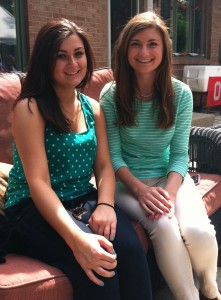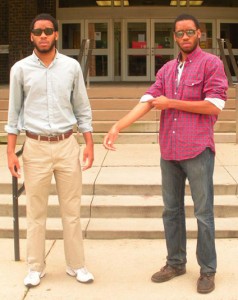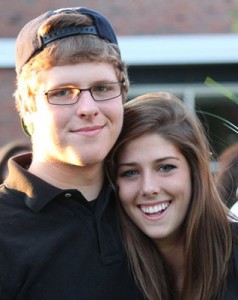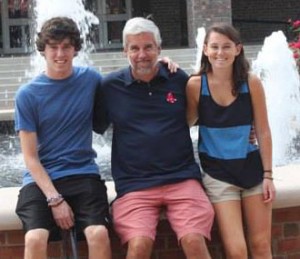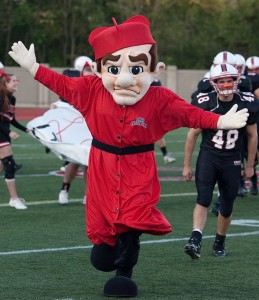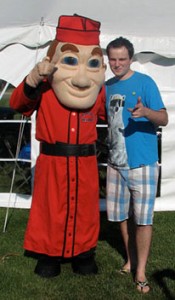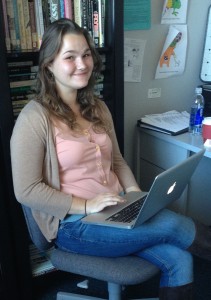By Elizabeth Childers
Transcript Correspondent
Editor’s Note: This story was written in May, and all attributed interviews were conducted in the spring. The story was published online in June, but The Transcript’s editorial staff feels it is still relevant to the campus community. Minor changes have been made to the original story to reflect its delayed print publication. To our knowledge, all the information published is still correct.
In 2010, when Ohio Wesleyan took over ownership of the fraternity houses on Williams Drive, it was decided that there needed to be an agreement between the fraternities, their alumni, Residential Life, campus foodservice provider Chartwells and groundskeeping and housekeeping provider Aramark on what each party would bring to the table to do the best for the university and the fraternity chapters.
This memorandum of understanding (MOU) was signed then, and it was decided it would be up for revision every three years. The 2012-2013 academic year was the first year in which MOU was revised, and frustrations were high in the discourse between the university and the fraternities.
“It’s a common agreement on paper,” said Dana Behum, assistant director of Student Involvement for Fraternity and Sorority Life, about the MOU. “It’s not as binding as a contract, but it is an agreement from both parties…It is a partnership between the university and fraternities. And that includes a lot of folks.”
Behum was the “in-between” person for the fraternities in their relations with the rest of the administration involved with the MOU. Wendy Piper, Director of Residential Life, said her department was involved in the original creation and in the revision.
“There is a change in the required occupancy level,” she said. “The 2010 MOU stated chapters had three years—until spring 2013—to reach 80 percent occupancy. The revised MOU states chapters must reach 85 percent occupancy by spring 2015 and 90 percent occupancy by spring 2017. There is also a change for those chapters who elect to have the university operate their kitchens, which allows chapters more options. The revised MOU allows chapters to decide if they want all of their meals to be provided in the house, if they want a combination of in-house meals and on-campus food points, or if they want to close their kitchens and have members choose one of the existing on-campus meal plans.”
Should a fraternity chapter on campus who currently has a house is unable to meet the occupancy requirement by the deadlines set, they are at risk of losing their house to other housing options on campus who may be able to fill those houses. Behum said in that event, the fraternity can petition to stay in its house because they are not guaranteed housing in that specific house the next year. As of spring 2013, two fraternity houses had to submit petitions to ResLife, and both have been permitted to continue living in their respective houses.
“They say, ‘We would like to petition to remain in our facility’ and Residential Life comes back and says, ‘Please share your plan to recruit more or how do you plan to correct this,’” Behum said about the petition process. “So they have a full calendar year to reach the occupancy level….They have to have a plan on paper to achieve it in the next year.”
Behum said it was not the university’s intent to remove the fraternities from their houses, because they would then have to fill them with random students. The goal, she said, was to keep the houses both filled and still in the hands of the fraternities.
Other sections of the MOU deal with how Buildings and Grounds responds to issues in the house and renovations to the house. It also outlines how the fraternity houses are cleaned.
“The gentlemen on campus asked for a lot more detail regarding cleaning the house…,” Behum said. “They requested more detail and solidity in when B&G would be responsible for repairs like a broken window or mold in the basement.”
Behum said some fraternities were more concerned with the B&G section than others. For example, one fraternity house had sewage leaking into its kitchen—which has been taken care of—and needed other remodeling and adjustments in April. Other concerns included cracking foundations and other plumbing issues.
“The common theme our men are unhappy with is the turnaround time with large projects which need to be fixed,” Behum said.
Fraternity reactions, according to Piper, varied by the chapter and the section of the MOU they had questions about.
“The occupancy level has surfaced as a concern; however, chapters that have historically demonstrated higher occupancy seem to have found this change less objectionable than those that have struggled with occupancy,” she said. “They also seem to appreciate that occupancy will be calculated on a three year rolling average, which will allow chapters to recover from (a) ‘lean’ semester of membership. Chapters that continue to self-operate their kitchen seem overall pleased to continue to have that option.”
Behum said the hike in the house occupancy is part of a campus-wide initiative to bring OWU to full capacity. Piper said it’s a goal to use residential facilities on campus to the best of abilities.
“As a residential campus, our goal is to make use of all residential facilities on campus, and for many years the fraternity houses had occupancies that were low,” Piper said. “Under the 2010 MOU, the chapters were given three years to reach a level of occupancy equal to at least 80 percent, which we felt was a reasonable goal given that their combined average occupancy (in 2009-2010) was about 66 percent. The expectation under the revised MOU aims to bring the fraternities to an occupancy level comparable to other university residences, which has been between 93 to 96 percent over the past five or so years.”
Behum said because fraternities were not filling their houses, “the document challenged them to put emphasis on recruitment.”
She said the fraternity chapters on campus as a whole met the 80 percent occupancy goal fairly quickly, and many of them exceeded it since the original MOU was signed.
The MOU revisions also dealt with events such as the 2012 Delta Tau Delta fire that were not addressed in the original agreement.
“…Some of the actions that were taken as a result of the fire, which had not been explicitly stated in the 2010 MOU, were incorporated into the MOU to guide future actions,” Piper said. “For example, after the fire, Residential Life relocated the residents and made a concerted effort to keep them located in close proximity to one another wherever possible so that we were not in effect dissolving their community. The MOU now states that in the event of a disaster or emergency that requires students to relocate, the university will work to provide a living arrangement where chapter members are grouped as reasonably as possible.”
Behum said in her experience, the MOU is more of an open dialogue between the university and the fraternities.
“Although it may not be a perfect agreement and my not reach everyone’s needs, it is a living document that we revisit now every four years instead of three…,” she said. “If men are upset (though) we can open the document again…(I)t’s to regulate communications between the university and the fraternities.”
Behum also said there are disadvantages to the MOU in that it can be difficult for all sides to be heard conversations around it can be difficult to have.
“There are fraternities who are having a difficult time getting a response for projects that need to be dealt with, and what better way than to talk about it frequently, get all the right people in the room and get things in motion,” she said. “While there may be disadvantages to different groups…but ultimately it is a positive.”
Some OWU fraternity brothers were frustrated by what the MOU revisions. A member of one house involved in listing the revisions the chapters wanted said he felt their voices weren’t really heard or considered during the final decision. Even though many of the fraternities were not satisfied, they felt they had no choice to sign it, since refusal would give the university the right to remove them from their houses. The member requested not to be identified for fear of himself as an individual or his fraternity being singled out.
“The first time the MOU was drafted and signed, the fraternities were very apprehensive about it, but they signed in good faith,” he said. “On paper it sounded great: the school would take care of the houses and provide everything, cleaning services…However, over the past couple years it really hasn’t been done to the best of the school’s ability.”
One example he gave of the school falling short on their promises was on the renovations and plans promised three years ago. He said despite the plans to extensively renovate the houses, in reality the renovations executed were small, inconsequential things compared to the major issues the houses had. Where a house was having large and costly foundational or plumbing issues, the university would instead tear out lofts, replace old locks in the building or paint and consider those renovations, rather than dealing with the larger issues in a timely manner.
He said in the case of the plumbing issue, which eventually caused a sewage line break in Alpha Sigma Phi, the school is only now being forced to deal with it since it is considered a hazardous living condition. Another house was facing similar problems with its plumbing.
“Each house has their own unique problems, and the school really hasn’t done anything to fix them,” he said.
The fraternity member said there were some tensions over the occupancy level for each house. The fraternities are concerned about the 90 percent occupancy because of how recruitment fluctuates.
“There was no real compromise with that, and it is frustrating because this is supposed to be a negotiation between two parties, but we’re kind of being forced into a corner because if we hadn’t signed by the deadline, the school had the right to take all our houses away, and that wasn’t something we wanted to risk,” he explained.
He said the only real compromise was the three year average for the 90 percent occupancy, even though they’re not quite sure how that will work in 2017.
The member said the decision to move the revisions from every three years to every four also put the fraternities at a disadvantage. Behum said many of the fraternity men weren’t apart or even on campus at the time of the MOU’s creation, and many of their complaints could come from the fact they see it as new information since they never had to deal with it before. Now, however, any student involved with any MOU revision will be unable to be involved in the one previous and the one after, making continuity in understanding what revisions should be requested very difficult for the houses.
“We wanted to keep it at three, so the freshmen now would have an understanding of what we went through, so they would have something to base their arguments on later,” he said. “But now, with the revision every four years, that’s not really possible.”
Though alumni of the fraternities were involved through the Alumni Inter-Fraternal Council (IFC), the fraternity member said undergraduate members didn’t have enough time to fully understand the MOU.
“We kind of knew about it—we had a draft, but we didn’t have the opportunity to argue our case,” he said. “The person we really were able to talk to was Dana (Behum).”
Fraternity members were only directed to speak with Behum and were not given the opportunity to meet with those who had the power to discuss and make changes to the MOU.
“They kind of just put on a play, saying we had a month to review it, and then never talked to us about it,” he said. “Then, a week before the deadline, they contacted us, saying, ‘Don’t forget to sign it.’”
The member said at that point the fraternity presidents got together, requested one more week to suggest revisions, and then went through the MOU line by line and listed the changes they wished to make. When they submitted the changes, they were not considered and the presidents were forced to sign because of the deadline.
“Collectively, all the fraternities didn’t want to sign, including the alumni, but we were kind of forced to,” he said. “It just comes back to the fact the school has the upper hand.”
The fraternity member said the Alumni IFC met with the university about those changes and the alumni from his chapter said they tried to make the same suggestions on behalf of the students, but the university administration still did not change the MOU.
“Students were allowed to go to the first two (MOU meetings), but then students were no longer allowed to go any more,” he said. “It’s kind of hard to argue things that affect every day life when you don’t have the perspective of someone living in the house every day. The alumni know about the huge problems but they don’t know about things like they’re not cleaning our bathrooms or picking up the trash or not taking care of things that break—things that happen every day.”
He said there was one person at the meetings representing all of the fraternities, but since it was really only one perspective and one voice, it wasn’t really heard in the decision making process.
The member said while the fraternity presidents were arguing against the changes made, they all became rather close and “a united front against a single enemy.”
“Most of the fraternities don’t like what’s going on at all,” he said. “No major negotiations were actually made. It was more of the school saying, ‘This is what’s going to happen.’”
As to food plans, the brother said the university was trying to direct all the fraternities to use Chartwells. The fraternities were able to decide whether or not to keep their kitchens under a separate contract—three of them have outside contracts with companies who supply them with chefs—or use Chartwells. But the MOU says that particular section can be revised annually, “meaning we’ll have to fight every year to keep our own kitchens.”
The fraternity member also said he was unsure why the university would continue with an MOU not really agreed upon by the fraternities when a large portion of donated money from alumni come from former members of the fraternities on campus.
He said the Greek alumni money is divided a certain way—80 percent to the houses and 20 percent to the university to use as it sees fit. He said he felt 20 percent should’ve gone to preventive measures in the house, such as the sewage or foundational problems, before they became an immediate living hazard. However, he said, the university refused to release their financial records of that money in light of all the renovations that haven’t been made.
“Why would you piss us off when all the money you’re getting is from our alumni?” he said.



